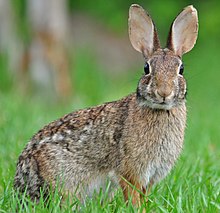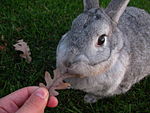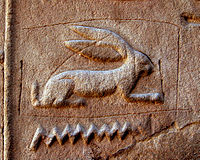Portal:Lagomorpha
The Lagomorpha portalThe lagomorphs (/ˈlæɡəmɔːrf/) are the members of the taxonomic order Lagomorpha, of which there are two living families: the Leporidae (rabbits and hares) and the Ochotonidae (pikas). There are 110 recent species of lagomorph of which 109 are extant, including 10 genera of rabbits (42 species), 1 genus of hare (33 species) and 1 genus of pika (34 species). The name of the order is derived from the Ancient Greek lagos (λαγώς, "hare") + morphē (μορφή, "form"). (Full article...) Selected article
Rabbits and hares in art have variable mythological and artistic meanings in different cultures. The hare is often associated with moon deities and signifies rebirth and resurrection. It is a symbol of fertility and sensuality, and appears in depictions of hunting and spring scenes in the Labours of the Months. Joseph Beuys, who always found a place for a rabbit in his works, saw it as symbolizing resurrection. The Welsh sculptor Barry Flanagan was best known for his energetic bronzes of hares which he produced throughout his career. (Full article...)
Selected breed
Chinchilla rabbits originated in France and were bred to standard by M. J. Dybowski. They were introduced to the United States in 1919. Apart from the Standard Chinchilla, there are two other breeds recognized by the ARBA: The American Chinchilla or "Heavyweight Chinchilla" is larger than the Standard Chinchilla but otherwise identical. The Giant Chinchilla is a result of crosses between Chinchilla and Flemish Giant breeds; it originates in the United States.
Selected quote
SubcategoriesRelated portalsSelected imageThe ancient Egyptian hare hieroglyph is a portrayal of an Egyptian desert hare, which the Egyptians called sekhat. This hieroglyph expresses the sound "oon" or "oonen"; it is also a symbol (ideogram) for the verb "to be" or "to exist". The written name of famous Pharaoh Unas also uses the hare hieroglyph.
Selected video
Did you know"Rabbit" in…Get involvedFor editor resources and to collaborate with other editors on improving Wikipedia's Lagomorpha-related articles, see WikiProject Mammals. Things you can do
TopicsAssociated WikimediaThe following Wikimedia Foundation sister projects provide more on this subject:
|















